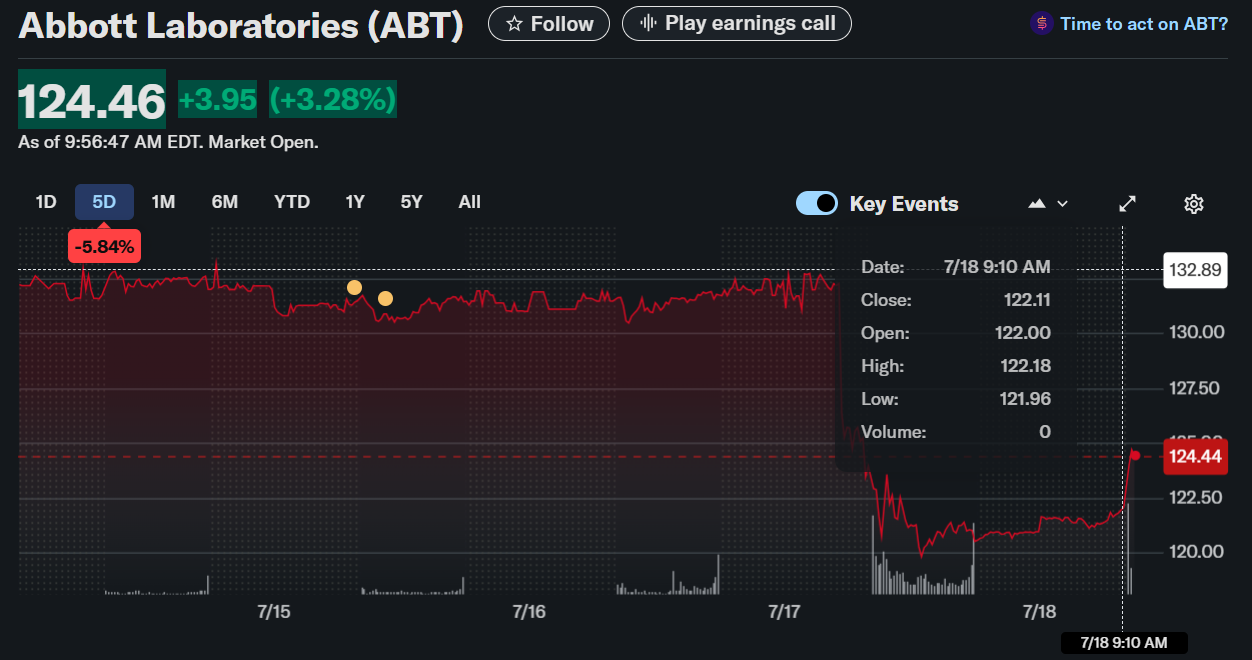TLDR
- Q2 EPS was $1.26, beating estimates, but shares fell 8.5% to $120.51
- Medical Devices sales surged 12%, led by diabetes and heart care
- COVID testing declines and China pressure hit Diagnostics revenue
- Tariffs and U.S. HIV aid cuts could cost Abbott over $1 billion in 2025
- Q3 EPS guidance of $1.28–$1.32 missed Wall Street’s $1.34 expectation
Abbott Laboratories (NYSE: ABT) reported Q2 2025 earnings on July 17, showing adjusted EPS of $1.26, an 11% year-over-year increase that beat analyst expectations by $0.01. The stock closed the day at $120.51, down 8.52%, as investors reacted to broader warnings around upcoming financial headwinds.

Total sales rose 6.9%, or 7.5% excluding COVID-related testing. The company saw a 100 basis point improvement in both gross margin (57%) and operating margin (22.9%) compared to the prior year, reflecting strong operational efficiency.
Medical Devices Drive Revenue Growth
Abbott’s Medical Devices unit delivered a standout quarter with 12% growth, powered by products in diabetes care, heart failure, cardiac rhythm management, electrophysiology, and structural heart solutions. Diabetes Care led the segment with 19.5% growth, generating $1.9 billion in quarterly sales.
Heart Failure products also saw a 14% sales increase, demonstrating strong demand across cardiovascular health solutions. Abbott continues to invest in its cardiovascular manufacturing, with a new facility planned in Georgia by 2028 and other sites underway in Texas and Illinois.
$ABT | Abbott Labs is -7.4% this morning.
🔹 EPS: $1.26 vs. $1.25 est. ✅
🔹 Revenue: $11.14B vs. $11.06B est. ✅Key takeaways:
🔸 Med devices revenue: +13% YoY
🔸 Organic sales: +6.9% YoY
🔸 FY EPS outlook: $5.15 ($5.05-$5.25 prior)
🔸 Q3 EPS outlook: $1.28-$1.32 prior pic.twitter.com/6LsJu9LI66— CMG Venture Group (@CmgVenture) July 17, 2025
Diagnostics and Global Market Headwinds
Despite strong overall growth, diagnostics revenue declined 1.5% in Q2. The drop was tied to lower COVID-19 testing demand and China’s volume-based procurement system, which forces device makers to offer steep discounts. CEO Robert Ford noted these dynamics could reduce revenue by $700 million in 2025.
U.S. government funding cuts to HIV testing programs and halted foreign aid are also hurting diagnostics performance in low-income countries. Abbott expects these and related policy changes to contribute to a total of over $1 billion in financial headwinds this year.
Tariffs, Outlook, and Margin Expansion
Tariff-related costs are now expected to total just under $200 million, mostly concentrated in the second half of 2025. While less than previously feared, the impact remains significant. The company had originally anticipated higher expenses earlier in the year.
Abbott projected Q3 2025 EPS between $1.28 and $1.32, missing Wall Street’s consensus estimate of $1.34. Despite this, management reaffirmed full-year sales growth guidance in the range of 7.5% to 8.0%, down slightly from prior estimates.
Conclusion
While Abbott delivered a solid Q2 driven by medical devices and posted better-than-expected earnings, the warning of upcoming financial strain from global policies, tariffs, and declining diagnostics weighs on its outlook. Investors are watching closely as margin gains may be offset by macroeconomic and regulatory hurdles in the second half of the year.






